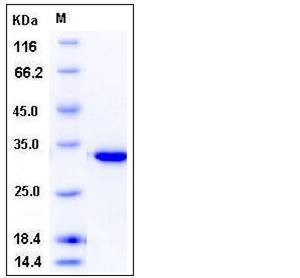Human Carbonic Anhydrase XIII / CA13 Protein (His Tag)
CAXIII,FLJ37995,MGC59868
- 100ug (NPP3634) Please inquiry
| Catalog Number | P10461-H08E |
|---|---|
| Organism Species | Human |
| Host | E. coli |
| Synonyms | CAXIII,FLJ37995,MGC59868 |
| Molecular Weight | The recombinant human CA13 consisting of 268 amino acids and has a calculated molecular mass of 30.3 kDa. It migrates as an approximately 32 kDa band in SDS-PAGE under reducing conditions. |
| predicted N | Met 1 |
| SDS-PAGE |  |
| Purity | > 96 % as determined by SDS-PAGE |
| Protein Construction | A DNA sequence encoding the human CA13 (NP_940986.1) (Met 1-His 262) was expressed, with a polyhistide tag at the C-terminus. |
| Bio-activity | Measured by its esterase activity . The specific activity is >7 pmoles/min/μg. |
| Research Area | Neuroscience |Sensory System |Visual system |
| Formulation | Lyophilized from sterile 20mM Tris, 0.5M NaCl, pH 8.0 1. Normally 5 % - 8 % trehalose and mannitol are added as protectants before lyophilization. Specific concentrations are included in the hardcopy of COA. |
| Background | The carbonic anhydrases (or carbonate dehydratases) are classified as metalloenzyme for its zinc ion prosthetic group and form a family of enzymes that catalyze the rapid interconversion of carbon dioxide and water to bicarbonate and protons, a reversible reaction that takes part in maintaining acid-base balance in blood and other tissues. The carbonic anhydrasekl (CA) family consists of at least 11 enzymatically active members and a few inactive homologous proteins. The CAXIII is a member of the CA family, which owns a globular molecule with high structural similarity to cytosolic isozymes, CAI, II, and III. Recombinant mouse CAXIII showed catalytic activity similar to those of mitochondrial CAV and cytosolic CAI. In human tissues, CAXIII expression was identified in the thymus, small intestine, spleen, prostate, ovary, colon, and testis. In mouse, positive tissues included the spleen, lung, kidney, heart, brain, skeletal muscle, and testis. In conclusion, the predicted amino acid sequence, structural model, distribution, and activity data suggest that CAXIII represents a novel enzyme, which may play important physiological roles in several organs. |
| Reference |
